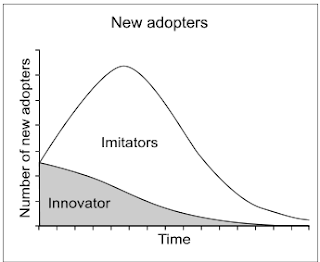The Bass Diffusion Model
Yesterday, Ashlie asked “what kinds of laws social media analytics is borrowing?”
One of the great tree trunks in Marketing Science is called the Bass Diffusion Model. It was published in 1969 by Frank Bass, in a paper entitled: “A new product growth model for consumer durables“. (Management Science 15 (5): p215–227)
Briefly:
- There are innovators and there are imitators.
- Each segment, innovators and imitators, adopt a new product at differing rates over time.
- The impact of Word Of Mouth can be modeled by the coefficient q
- The impact of Advertising can be modeled by the coefficient p
- The coefficients cause different product adoption curves
- The model can be used to predict the impact of word of mouth on product diffusion
The coefficient q used to be much lower than it is today. The Internet, and later, social media, caused q to increase. Statements about the effectiveness of social media marketing sometimes make reference to the coefficient q without explicitly stating it.
Check out the diagram below, sourced from the wikipedia article on the subject:
The chart below shows that classic ‘S’ shape in product (and disease) diffusion.
The chart below shows the adoption rate of two different segments of people – innovators and imitators, over time.
And finally, you put it all together, and you get the diminishing marginal return chart between the two segments. Innovators falls off, imitators rise, and the company wins.
Pretty neat, right?
(Fun fact: (EDIT – HUO et al, 2012) has recently demonstrated, using the CD diffusion dataset (It’s why I was excited about Beluga yesterday), that if you add one extra model on top of the Bass Model, you replicate Moore’s Chasm.)
1969
This is science that was published in 1969, before Granovetter, and has been extremely influential in Marketing Science ever since. It’s fundamental. We don’t have to rediscover a whole bunch of knowledge in an effort to ‘prove’ or ‘attribute’ social media marketing. It’s been done for such a long time already.
Our only problem is that nobody actually checks before running their mouths about how it can’t be done.
So, Ashlie, this is probably the most fundamental natural law that underpins social analytics. I estimate that it’s well known to a couple thousand academics and industry marketing scientists, so much so to the point where it’s boring and we’ve moved on to talking about how coefficient q has been impacted by technology.
***
I’m Christopher Berry.
I tweet about analytics @cjpberry
I write at christopherberry.ca



